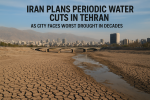Iran is preparing to introduce scheduled water cuts across Tehran, a city of more than 10 million residents, as the country grapples with its worst drought in decades.
According to local authorities, rainfall levels in the capital have plummeted to the lowest in a century, with nearly half of Iran’s provinces experiencing months without a single drop of rain. The crisis has intensified fears of severe water shortages, forcing the government to take drastic conservation measures.
Several local outlets have already reported dry taps overnight in parts of Tehran. Energy Minister Abbas Ali Abadi, speaking on state television, emphasized the necessity of the move:
“This will help avoid waste, even though it may cause inconvenience,” he said.
President Masoud Pezeshkian went a step further in a televised speech, warning that Tehran might face evacuation if the situation does not improve before year’s end—though no plan for such a massive relocation has been detailed yet.
Nestled at the foot of the Alborz Mountains, Tehran usually depends on autumn rains and winter snow to replenish its water supply after long, scorching summers. This year, however, reservoirs are running dangerously low.
At the Amir Kabir Dam, one of five key reservoirs feeding the capital, water levels have dropped from 86 million cubic metres last year to just 14 million cubic litres today, said Behzad Parsa, Director General of the Tehran Water Company. This reserves enough water for less than two weeks of supply for the entire city.
Across Iran, other regions including Isfahan, Tabriz, and Mashhad are witnessing similar struggles, with officials considering night-time water cuts and urging residents to conserve every possible drop.
Over the summer, Tehran even declared two public holidays in July and August to curb water and energy consumption during the blistering heatwave, when daily power outages became a common ordeal.
As the nation braces for tougher months ahead, experts warn that unless substantial rainfall arrives soon, Iran could face one of the most critical environmental emergencies in its modern history.
This is not just a crisis of water—it’s a wake-up call about sustainability, preparedness, and the shared responsibility every citizen bears in safeguarding natural resources. The human cost of drought is real, but so too is the power of collective action.







